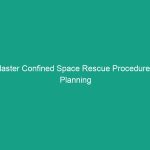Introduction
In today’s fast-paced work Environment, ensuring the Safety and health of employees is more critical than ever. Health, Safety, and Environment (HSE) practices not only protect workers but also enhance productivity and organizational reputation. Advanced risk management techniques are essential for identifying, assessing, and mitigating risks in the workplace. By implementing these techniques, organizations can foster a culture of Safety that minimizes accidents and incidents, ensuring a safer work environment for all. This article will delve into various advanced risk management techniques, their importance, and practical applications to create safer workplaces.
Understanding Advanced Risk Management Techniques
What Are Advanced Risk Management Techniques?
Advanced risk management techniques refer to systematic approaches that organizations employ to identify, evaluate, and mitigate risks associated with Workplace Safety. These techniques are designed to go beyond traditional risk management practices, incorporating innovative methods and technologies. They focus not only on compliance with regulatory frameworks but also on proactive measures that anticipate potential Hazards. Examples include risk assessment methodologies, behavioral safety programs, and the use of data analytics to predict and prevent accidents.
The Importance of Risk Management in HSE
Implementing advanced risk management techniques is crucial for several reasons. Firstly, it enhances compliance with legal and regulatory requirements, minimizing the risk of penalties or legal action. Secondly, effective risk management leads to reduced workplace injuries and illnesses, which can translate to lower insurance costs and improved employee morale. Furthermore, a robust risk management framework fosters a proactive safety culture, where employees feel valued and are more likely to engage in Safe Practices. Overall, these techniques contribute to sustainable business operations and long-term success.
Regulatory Frameworks for Risk Management
Understanding HSE Regulations
One of the first steps in implementing advanced risk management techniques is understanding the regulatory frameworks that govern Workplace Safety. Regulations vary by country and industry but generally encompass Standards set by organizations such as the Occupational Safety and Health Administration (OSHA) in the United States or the Health and Safety Executive (HSE) in the United Kingdom. These regulations outline employers’ responsibilities regarding employee safety, risk assessments, and reporting Procedures in case of incidents.
Key Regulations Impacting Risk Management
- osha Standards: OSHA provides comprehensive guidelines on Workplace Safety, requiring employers to conduct regular risk assessments and maintain safe working conditions.
- ISO 45001: This international standard specifies requirements for an Occupational Health and safety (OH&S) management system, helping organizations improve employee safety and reduce workplace risks.
- Environmental Regulations: Compliance with environmental laws is essential for organizations that handle hazardous materials, impacting risk management strategies significantly.
Integrating Regulatory Compliance into Risk Management
To effectively integrate regulatory compliance into risk management, organizations should establish a compliance management system that continually assesses and updates safety practices. Regular Training sessions should be conducted to keep employees informed about the latest regulations and their roles in maintaining compliance. Furthermore, organizations can utilize audits and inspections to identify any gaps in compliance, ensuring that risk management techniques align with regulations.
Best Practices for Implementing Advanced Risk Management Techniques
Conducting Comprehensive Risk Assessments
A critical component of advanced risk management techniques is the conduct of comprehensive risk assessments. This process involves identifying potential Hazards, evaluating the risks associated with those hazards, and determining the appropriate Control Measures. Risk assessments should be conducted regularly and whenever there are changes in the workplace, such as new equipment or processes. Involving employees in the risk assessment process can provide valuable insights and promote a culture of safety.
Utilizing Technology and Data Analytics
Technology plays a vital role in modern risk management. Organizations can leverage data analytics to gain insights into accident trends, identify high-risk areas, and predict potential incidents before they occur. For example, using machine learning algorithms, companies can analyze historical data to forecast future risks, allowing for proactive measures. Additionally, implementing safety management software can streamline the risk assessment process and enhance communication among employees regarding safety protocols.
Training and Engaging Employees
Employees are the backbone of any safety program. Engaging and training employees on advanced risk management techniques is paramount. Regular training sessions should cover not only the procedures but also the reasons behind them, fostering a deeper understanding of the importance of safety. Safety drills and simulations can also enhance employee preparedness for emergency situations, ensuring that they know how to respond effectively in case of an incident.
Promoting a Safety Culture
Creating a culture of safety within the organization is essential for the success of advanced risk management techniques. Leadership should demonstrate a commitment to safety by prioritizing it in decision-making and encouraging open communication about risks and safety concerns. Recognizing and rewarding safe behavior can also motivate employees to adopt safer practices. When safety becomes a core value of the organization, it leads to higher levels of employee engagement and a significant reduction in workplace incidents.
Case Studies: Success Stories in Advanced Risk Management
Case Study 1: Manufacturing Sector
A large manufacturing company implemented advanced risk management techniques following a series of workplace accidents. They began by conducting thorough risk assessments, identifying critical hazards in their operations. Utilizing data analytics, they monitored incident trends and adjusted their safety protocols accordingly. As a result, the company saw a 40% reduction in workplace injuries over two years, demonstrating the effectiveness of proactive risk management.
Case Study 2: Construction Industry
In the construction industry, a leading firm adopted advanced risk management techniques to address the high rates of accidents on job sites. They introduced a comprehensive training program focused on identifying and mitigating risks before they could lead to incidents. Additionally, they utilized wearable technology to monitor employee safety in real-time. This initiative resulted in a significant drop in accidents, and the company gained recognition for its commitment to safety, enhancing its reputation in the industry.
Case Study 3: Healthcare Sector
A healthcare organization faced challenges with patient and staff safety due to the inherent risks in medical environments. By implementing advanced risk management techniques, including robust reporting systems and employee training, they were able to significantly improve safety outcomes. The organization established a culture of safety, encouraging staff to report near misses and unsafe conditions without fear of reprisal. This approach led to a 30% decrease in workplace incidents, showcasing the Benefits of a proactive risk management strategy.
Challenges in Implementing Advanced Risk Management Techniques
Resistance to Change
One of the main challenges organizations face when implementing advanced risk management techniques is resistance to change. Employees may be accustomed to traditional methods and may be hesitant to adopt new practices. To overcome this challenge, organizations should communicate the benefits of the new techniques clearly and involve employees in the transition process. Providing training and support can also help ease the transition and foster buy-in from staff.
Limited Resources and Budget Constraints
Many organizations struggle with limited resources and budget constraints, which can hinder the implementation of advanced risk management techniques. However, effective risk management does not always require significant financial investment. Organizations can start by leveraging existing resources, such as utilizing in-house expertise for training and risk assessments. Additionally, prioritizing high-risk areas for immediate attention can lead to meaningful improvements without overwhelming budgets.
Keeping Up with Regulatory Changes
Regulatory frameworks are continuously evolving, which can pose a challenge for organizations striving to maintain compliance. Staying updated on changes in regulations requires ongoing effort and resources. Organizations can establish a compliance team responsible for monitoring regulatory developments and ensuring that the risk management framework is adjusted accordingly. Utilizing technology, such as compliance management software, can also streamline this process.
Future Trends in Advanced Risk Management
The Role of Artificial Intelligence
Artificial intelligence (AI) is poised to significantly impact advanced risk management techniques in the coming years. AI can analyze vast amounts of data quickly, providing insights that human analysts may overlook. Predictive analytics powered by AI can help organizations identify potential risks before they materialize, allowing for proactive intervention. As AI technology continues to evolve, its integration into risk management strategies will become increasingly essential for enhancing Workplace Safety.
Increased Focus on Mental Health
As organizations recognize the importance of mental health in the workplace, advanced risk management techniques will increasingly encompass psychological risks. Addressing mental health concerns is essential for creating a safe and healthy work environment. Organizations will need to implement programs that promote mental well-being, such as stress management training and employee assistance programs, as part of their overall risk management strategy.
Emphasis on Sustainability and Environmental Risks
With the growing emphasis on sustainability, organizations will need to incorporate environmental risks into their advanced risk management frameworks. This includes assessing potential environmental impacts of workplace activities and implementing measures to mitigate those risks. By prioritizing sustainability, organizations can not only comply with regulations but also enhance their reputation among consumers and stakeholders.
Conclusion
Advanced risk management techniques are crucial for creating safer workplaces and ensuring compliance with health, safety, and environmental regulations. By understanding the regulatory frameworks, implementing Best Practices, and learning from successful case studies, organizations can develop effective risk management strategies. While challenges may arise, the future of risk management looks promising with the advent of new technologies and a growing focus on mental health and sustainability. We encourage all organizations to prioritize safety and invest in advanced risk management techniques to foster a culture of safety and well-being. Together, we can work towards safer workplaces for everyone.


